Accessing ASMOTW files. 12 out of 2984 viewed. Access article directory 'Week 3'. Subject: Raven. Accessing....
Welcome back, faithful viewers. We started with the very first BattleMech ever conceived. We continued with one of the newest OmniMechs in existence. Today, we'll be going back a little bit, but in several ways we're staying on the bleeding edge of 'Mech development.
By that, of course, I mean the very first stirrings of rediscovering the advancements of the Star League after two hundred and fifty years of Succession Wars. The Raven isn't the first new 'Mech in the Inner Sphere in hundreds of years (that'd be the Merlin, senior by 14 years), or even the second (that'd be the Marauder II, if we're counting Wolf's Dragoons units, or the Hatchetman, if they don't count as Inner Sphere enough), but it does have the first instance of newly produced electronics warfare equipment in over two hundred years. Let's take a look under the hood.
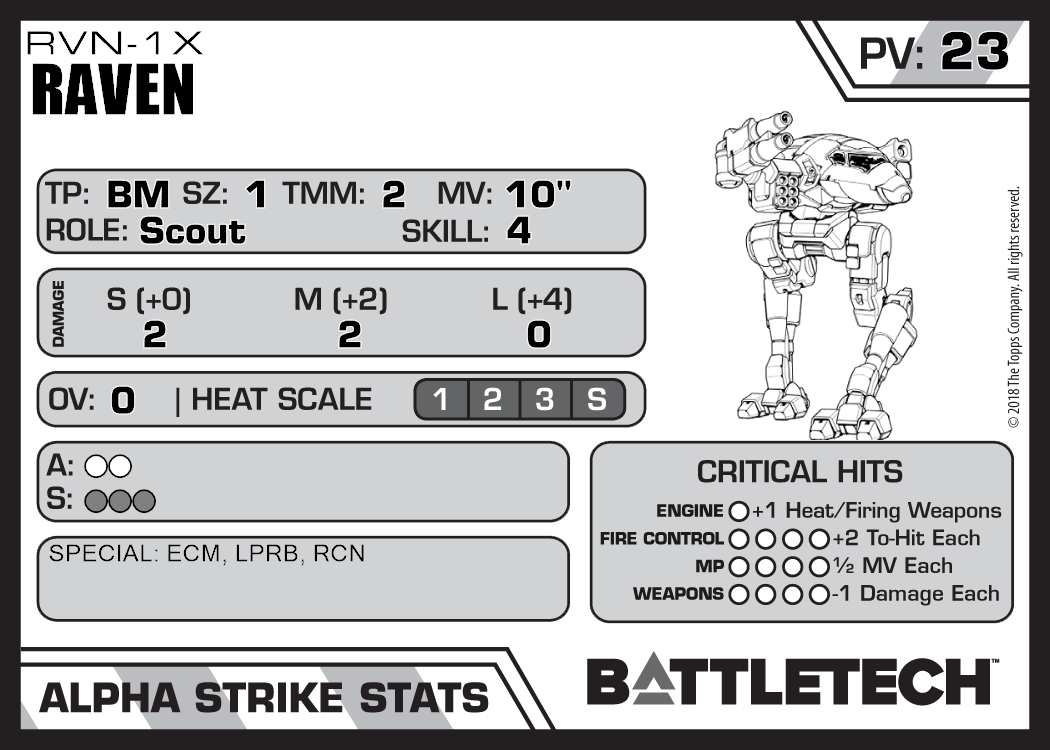
Now, let's get started the same way we always do. In that fashion, we notice the first major difference between the Raven and the two previous 'Mechs. Size 1. We are looking at a Light 'Mech for the first time in this series of articles. What does that mean, in Alpha Strike terms? It means that if you're in melee range and arc you have made some poor life choices. It also means you can go places. Much like in standard BattleTech, lighter 'Mechs have a better time jumping to and from buildings and crossing bridges.
… And that's pretty much it. Size doesn't play a big role in Alpha Strike aside from those two things clear until you get to
engine explosions. But as BattleTech players the tonnage and size of a unit is hard-coded into our brains as significant, and it's a good way to determine what to generally expect, if not everything you can get.
Next up, weapons. With a damage profile of 2/2/0, the Raven -1X is far and away the least painful thing we've seen. It's also the first 'Mech to be unable to respond in the long range bracket. Usually (and I do say usually) on a Light that's not a huge problem. Two points of damage isn't bad. You'll hear me say this week in and week out, but you get what you pay for. The Raven's damage is worth a whopping total of 6 points out of its 20 total points cost. No overheat means both that you're not paying points for it, and that you're also not getting it. I'll leave it up to you whether those cancel each other out.
Now, the part of this particular Raven that's not usual is the speed. Ten inches isn't fast for a 'Mech this size. The Mad Cat Mk IV from last week matches it forty tons and two sizes heavier. Against other Lights, a 'Mech this slow is a sitting duck, and against lots of heavier things it can't keep the range open well enough or capitalize on any range it may have. Clearly, this 'Mech is not designed to go toe to toe with other designated combat units. The armor supports this. Two points of armor and three points of internal structure put this little birdy firmly within easy range of being outright one-shot by several versions of the 'Mechs we've already gone over. With a TMM of 2 from the 10” of movement, the Raven is fragile and fairly anemic. It's clearly not designed to go toe to toe with dedicated combat units. How else do we know that? Well, keep reading.
The Raven's bread and butter is EWAR. The -1X is... arguably still missing the core of its capabilities in this variant, but we still see a glimmer of the potential begging to be realized. Well, that's not particularly true. We see that there's
something in there, but I don't know if “potential” is the right word for it just yet. The first entry in the Special box is LECM. ECM? Aw, hell yeah! Get the dial-up tones and obnoxious music pumping loud and confuse the hell out of everyone with decent electronics. Eat your heart out, C3. Goodbye Narc beacons. Take a hike, active probes. Wait, what was that? Two inches of range?
No, that's not a typo. That Hatchetman I mentioned in one of those really early parentheticals? It can (and will) happily cut your face off with a hatchet at the exact same range your ECM will start to affect anything. Let that sink in for a minute. Your EWAR equipment is
matched in effective range by
melee weapons. You literally have to be within face-cleaving distance in order for this to be useful. Which means it's not useful. At all. It also costs a half point while the other specials on this 'Mech cost whole point(s) each, so this is why the -1X is 20 points instead of 19. For shame, LECM, for shame.
LPRB and RCN manage to slightly redeem this travesty of an EWAR platform. I went over PRB and RCN on the Mackie article, and LRPB does the exact same thing except at a shorter range. I realize, going over the older article, that I neglected to mention several of the capabilities and differences – I got caught up on RCN. PRB, unlike ECM, has a pretty substantial range. Eighteen inches for the standard version, and 'only' 12 inches for the light version. Probes can be used to detect hidden units that get in range, and also have the added bonus of making artillery they spot for more accurate.
...We'll go into artillery in a different article. There are a lot of Ravens to cover.
So, what else do we get for bringing this thing along? We get a Scout. There are a lot of Scouts in the game. Over two hundred, just in different 'Mech variants. Scouts are essential in forming Recon Lances and Light Battle Lances, and are arguably the most restrictive possible unit type to fill out a Command Lance (when the other options are Brawlers or Strikers). Light Battle Lances are questionably worth it if you have absolutely nothing else, but Recon Lances are worth their weight in gold to larger units with indirect fire capability. The -1X is still slow, however, and still doesn't punch very hard, and still has some armor issues. If you absolutely need to fit the most basic EWAR equipment you can possibly find on the field, 20 points might get you there.

What's the difference between the Raven -1X and the Raven -2X? The 2X trades every single Special on the unit in exchange for one point of OV and one point of armor leaving us with a total combined armor and structure of six points. The net result is a unit that is wholly useless in a non-combat role except for scouting with the Mk I Eyeball, but can actually dish out a reasonable amount of damage to units in its weight class. One point of extra armor is enough to avoid getting outright one-shot by units with 5 damage at short and medium, which is helpful if the -2X suddenly finds itself in its ideal engagement bracket with anything larger than a modern low-end heavy. The vulnerability to two groups of 3 points each doesn't protect it very much from things smaller than that, either. The lack of long range still hurts, and the requirement to heat up in order to reap the benefits of extra damage makes it a tough choice, especially when a single point of heat immediately drops you back down to 8” of move and a TMM of 1. It's... well, it's hard to be worse than a -1X, but the -2X gives it a good go, especially when you keep the same points cost at 20.
The more interesting change is the role. Losing the EWAR equipment turns the -2X into a Striker, which is much more interesting in terms of which lances you can build with it. Or, rather, it would if the -2X could move faster than 10”. This particular Raven can squeeze into a Striker Lance of any stripe (my personal favorite lance type) or even amusingly still a Recon Lance, and the Command Lance is still open for business. Losing out on the Light Battle Lance isn't a huge deal.
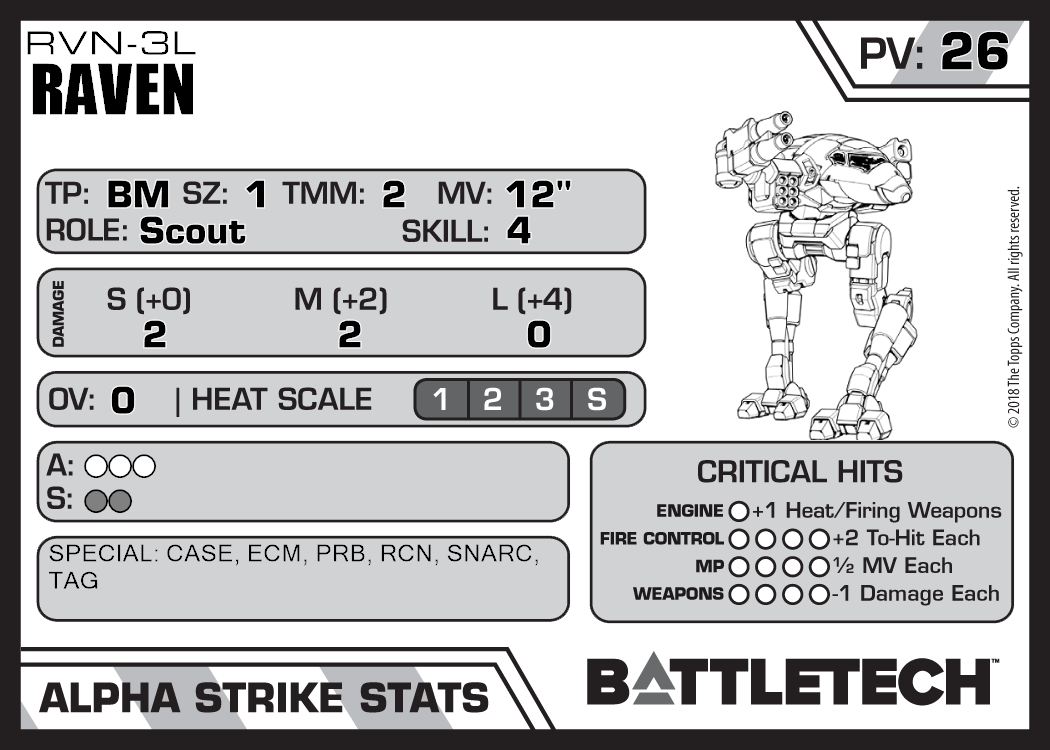
Now we're talking. This is the Raven -3L, and the first raven that's really worth using besides cheap filler in a Lance that needs a Scout or Striker. The very first thing one should notice when browsing this unit card, especially when compared to the previous Ravens, is the movement. Twelve inches isn't enough to graduate to the next TMM, but it
is enough to keep up with a good deal of Lights and low-end Mediums you'll see on the field, particularly in the time period. No more getting sucker punched at long range for this Raven! You're also guaranteed to outrun pretty much any Heavy you encounter, which previously wasn't the case. The upgrade in maneuverability and ability to dictate range are very welcome gifts.
The damage the Raven dishes out hasn't changed, but has lost OV. Now that the -3L has the speed to absorb a point of heat before losing the +2 TMM, this is slightly more of a blow than losing it on the -2X for absolutely no reason would have been. The armor and structure have also flip-flopped from the original -1X. XL engines and extra armor at tonnages this low are made for each other. Armor is always better than structure in terms of absorbing damage, and keeping the same number of points but gaining more relative armor is a good thing. The -3L is back in that annoying range where things that do 5 damage erase it from the board in one hit. Those things are common enough for this to be a valid concern in most areas of play.
The Special box also gets crowded again, and here the -3L distinguishes itself. We see CASE make an appearance, protecting against the miniscule chance of ammunition explosion. Nothing wrong with that, since it's free. We also see the non-L versions of ECM and PRB. Standard ECM gets a
lot compared to LECM. Twelve inches is a gargantuan range compared to the positively shrimpy 2” that the LECM could muster. Trying to disrupt C3 nets or deprive Narc bonuses got a lot easier, and you can now effectively hide your
lance from an active probe, rather than just yourself and that bum huddling under your 'Mech for protection from the rain. ECM can be run in both ECM mode and ECCM mode, so canceling out hostile ECM fields is also much, much easier with a full suite.
After that we have some new arrivals. SNARC and TAG combine to turn the Raven -3L into a machine that practically sets the benchmark for EWAR and support functions. Both of theses Specials have a relatively rare attribute, too. We'll start with TAG, since its effect is relatively easier to explain.
A unit with the TAG Special may, during the combat phase, elect to perform what is essentially a separate weapon attack. If the attack hits, the defender is considered tagged for the duration of that turn. Tagged units... don't tend to survive very long, at least on my battlefields. TAG is used to designate targets for homing artillery and semi-guided LRM munitions. With homing artillery, the bar to hit is automatically set to 4+ on 2d6. Considering that normal artillery with a spotter that doesn't have TAG or any of the PRB, LPRB, RCN, or BH Specials is made at gunnery
plus four, that's pretty significant. With S-G LRM ammunition, attacks against a tagged target do a point of extra damage when made as a normal weapon attack if the unit has the LRM special. Pretty sweet. Or, if the numbers are a bit too high for your tastes, you can make a separate LRM attack at a -2 to hit. Even sweeter. Those bonuses apply to indirect fire, too, so you get double the fun, and can even more than counteract the indirect fire modifier. Unfortunately, TAG doesn't count as the firing unit “spotting” for the attack, so PRB and RCN don't lend their own modifiers to the attack, otherwise it'd be downright silly. TAG may be used in the short or medium range brackets. Its smaller cousin, LTAG, may only be used in the short range bracket, but is otherwise identical.
SNARC works similarly, but with different equipment and abilities. The major thing they share is that SNARC is performed as an extra weapon attack. Yes, a Raven -3L that elects to may perform three separate weapon attacks in a single turn: One for a standard weapon attack, one for TAG, and one for SNARC. An SNARC attack that hits results in the struck unit operating under its effects for the remainder of the game, as long as its outside a friendly ECM zone. The fun part is that any attack made against the unit that utilizes a missile weapon Special, like firing indirectly, or having SRM or LRM in the Special block deals an additional point of damage to the target.
There's a pending question in the Rules Questions forum to clarify whether that means that a unit that has been both tagged and NARCed will suffer
two additional damage, however silly it may be to end up doing 90 BattleTech scale damage with a single LRM-10.
Now that's a support unit! The -1X and -2X are sniveling brats compared to the -3L's glorious support capabilities. The extra speed helps, and the armor/structure flip makes it more durable than the -1X and only barely less so than the -2X. Truly, an effective unit at last. Coming in at 24 points, it feels worth it, especially if you're going to be deploying a missile heavy force, or expect to come into contact with significant C3. With the Striker role, this particular Raven can do anything and everything that the -2X does in terms of lance composition, but can also contribute to and qualify for inclusion in a Pursuit Lance. Next to Striker Lances, Pursuits Lances are my favorite, and having a good support unit for that role is invaluable.
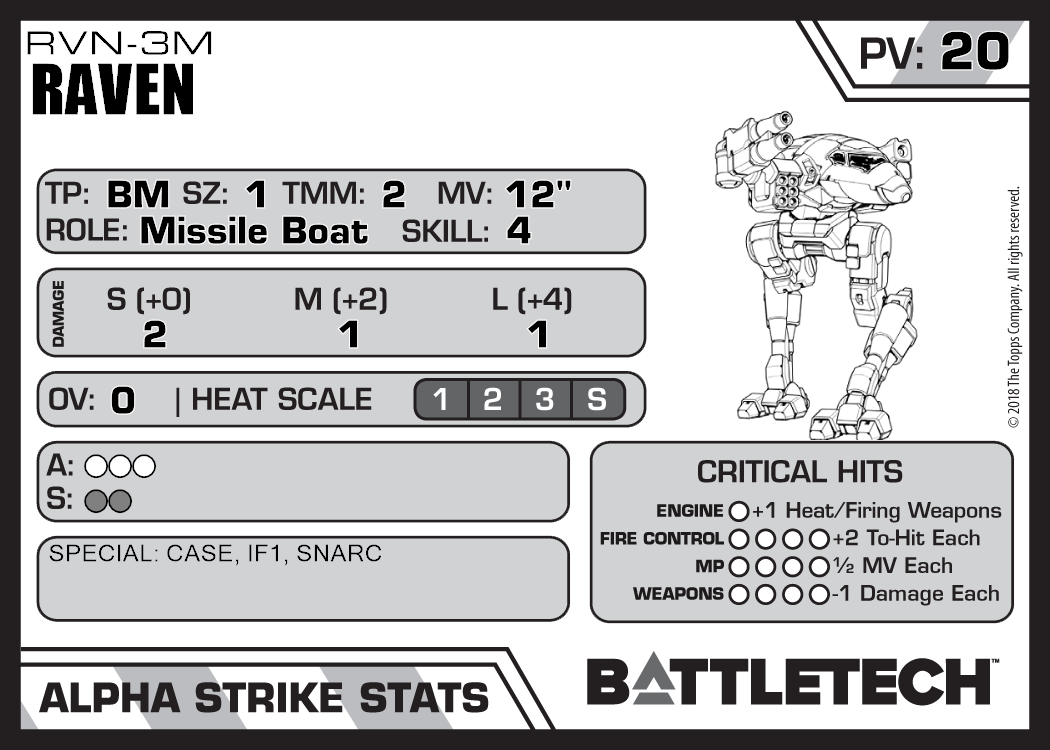
The Raven -3M is slightly different from the three variants that came before it alphabetically. It keeps the speed, and the armor and structure layout of the -3L, but the weapon damage has been rearranged slightly. This is the first Raven with any long range damage to speak of, managing a 2/1/1 curve. With the inclusion of long range damage, the Raven can now act as a true Light should when confronted with larger 'Mechs – stay at range and plink away if they can't respond, and run and hide if the can.
What makes the -3M even more different is what it changes to get that point of long range damage. Most of the Specials are gone, leaving just CASE and SNARC from before. Also included, now, is IF1. If after what I just told you about SNARC and IF isn't already tickling your fancy, you need to have your fancy examined by a medical professional. A single Raven can play merry hell with an opponent if it manages to get a NARC onto target. Once it does so, it can simply retreat behind cover and lob missiles until something connects – and eventually something will definitely connect. NARC also removes the need for a spotter, making this a powerful addition to a solo-minded group. It's not everyday you find a unit that can spot
for itself and still remain mostly effective.
At 19 points, the -3M is the cheapest Raven we've seen so far. Its role also makes it fairly flexible in lance assignments. As a Missile Boat, the -3M can form the basis of a Fire or Fire Support Lance. It's a bargain doing so, too, coming in inside the top 15 cheapest Missile Boat 'Mechs in the game.
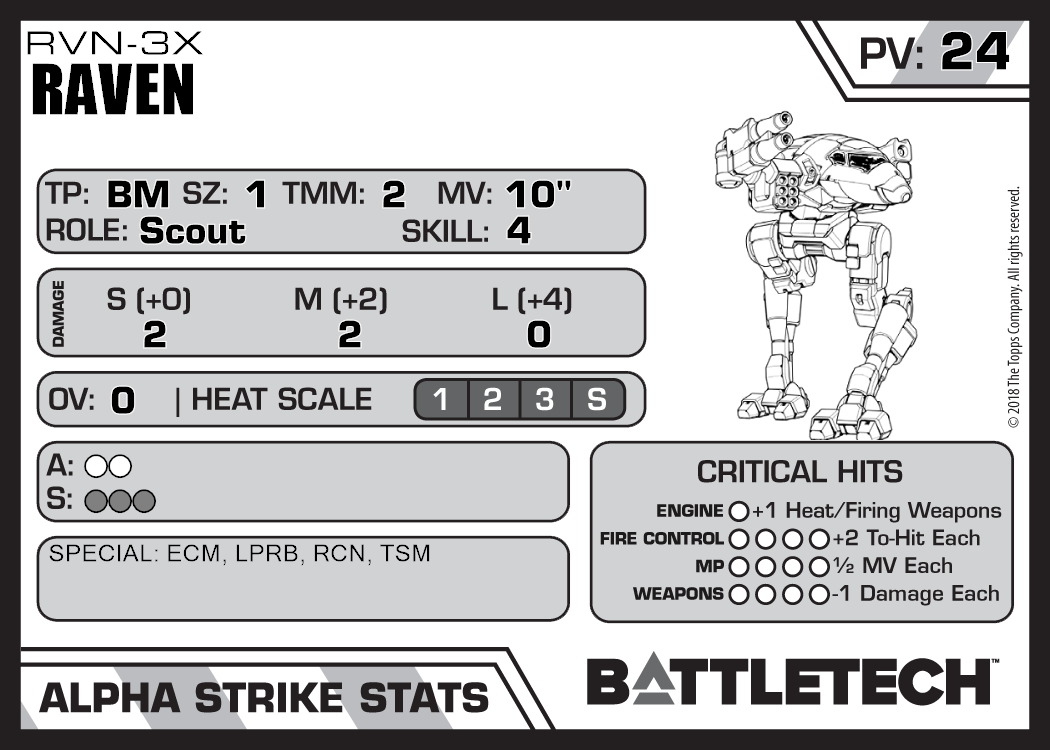
After the gleaming paragons of support might that are the Raven -3L and -3M, the -3X is almost identical to the -1X in Alpha Strike terms. Every single thing about it is identical, except for one Special and the points cost. The Special is TSM. TSM on a Raven is one of the most baffling things you'll ever see. In order to use it, you must first have at least one point of heat. While heated up, the 'Mech's speed is increase by 2”, and the physical attack damage is increased by one point. Given that this is a fairly slow Light 'Mech, this is met with a resounding, uproarious “WHY?” The -3X doesn't have an OV value, but fortunately in Alpha Strike you're still allowed to declare voluntary heat gain, so you're not perpetually stuck with a useless unspent point for the entire game until you take engine damage or some flamer plasma.
Considering that it costs a full extra point, the -3X is arguably worse than the -1X and -2X both for its points at 21. Truly a head scratching decision in Alpha Strike terms.
On the bright side, the role is still Scout, so you can find
some use for it filling out your Recon Lances if all else fails.
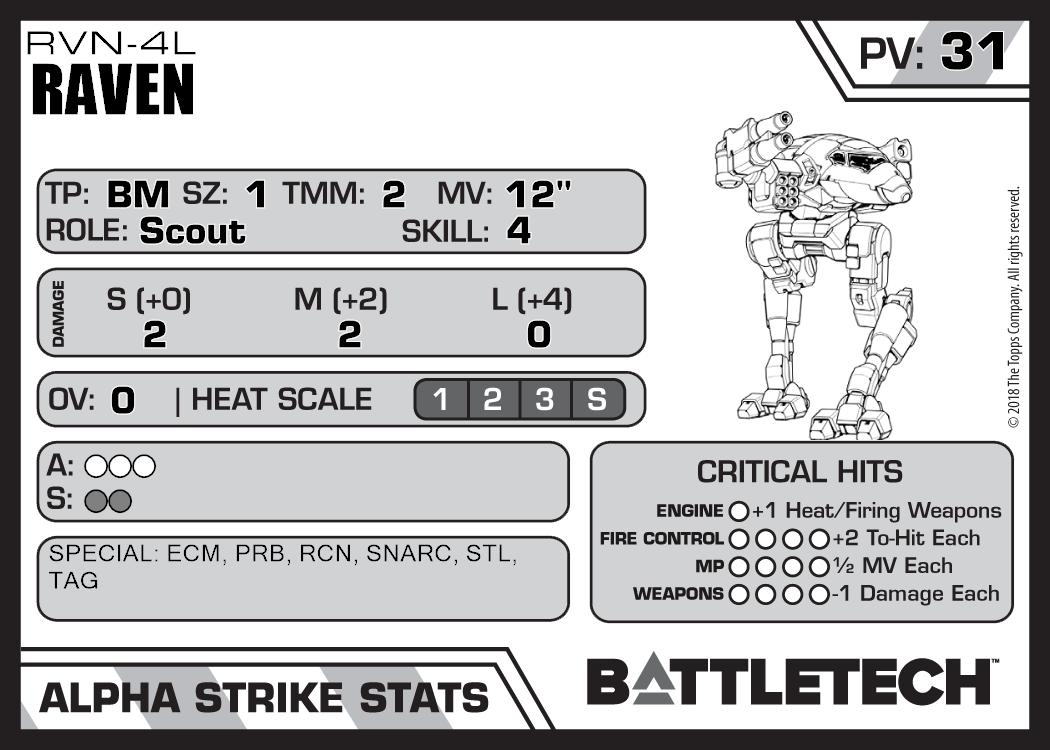
The Raven -3L was a thing of beauty. The Raven -4L is an upgrade. That is to say, nearly everything is the same. The only major change of the entire design is to remove CASE (which on a unit with 2 structure is arguably not useful) and add STL. STL, as you may have already surmised, is stealth armor. The effects of stealth armor in Alpha Strike are very similar to the effects of stealth armor in the standard tactical game. An additional +1 to be hit at medium range, and an additional +1 to be hit at long range. The Raven is already fragile, so adding STL to it is a perfect use of the system. Stealth is the entire contribution toward the extra points it costs to field a -4L at 26 points (over the -3L's 24). It's arguably worth it, especially if it keeps you around a turn or two longer. All of the support equipment remains in place, meaning that now you can do everything the -3L could except while being even more aggravating doing it. A true Capellan masterpiece.
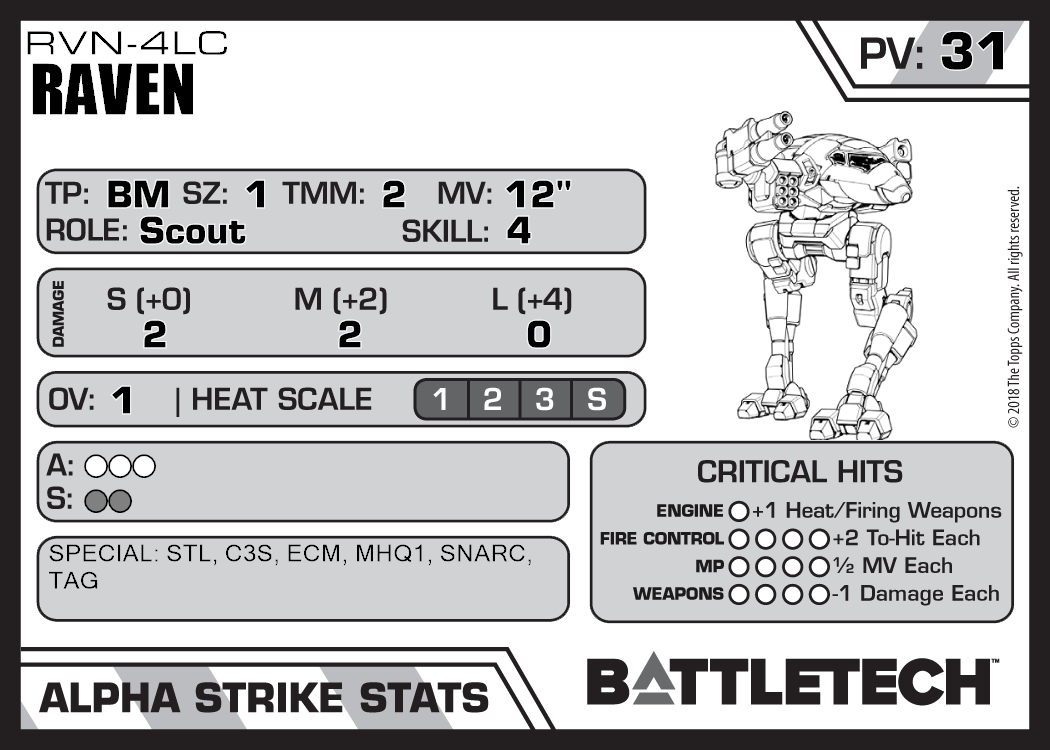
If it seems like these descriptions are getting shorter and shorter, they are. The one boon I get for writing about a 'Mech with 11 variants is that several of them are very similar to several others. This is how I stay sane.
The Raven -4LC (which, to my immense disappointment, does not stand for Lyran Commonwealth) similar to
several variants of Raven, but all in different ways. Which means I have to explain them all. Sigh.
Damage is pretty standard for a Raven at 2/2/0. The lack of long range punch continues to haunt the design through the years. Armor remains the -3L/-4L standard at three armor and two structure. Still fragile, but better than the first Ravens. Twelve inch move keeps it up to speed with most low-end mediums and many lights of the day. Where things start to get interesting again is the OV. It's back, and this time it's finally on a chassis that can handle a point of speed without dropping into the “please kill me” TMM category. That gives the design some much needed punch at medium range. Three points is enough to threaten most scout hunters, and the potential for extra damage should do well to keep away more fragile things.
Where it continues to get interesting are the Specials. The active probe is gone, and with it PRB and RCN. That loss hurts in the Battlefield Intelligence and initiative bonuses category (see the Mackie article for full details on BI), but the -4LC makes up in other categories. Namely, the presence of C3S makes up for a whole lot. That represents a C3 Slave on the unit. I'm not going to go into how C3 works in this article (this line just found its way onto my sixth page in Word), but that's a huge force multiplier. If you already know how C3 works, good. If you don't, wait a few weeks.
With the C3 Slave also comes a curious MHQ1 Special. MHQ1 doesn't make all the way back up for losing RCN (net loss of one point of BI), but it helps, contributing a single point on its own. RCN and MHQ contribute to separate pools of initiative bonuses (i.e. each one has a different initiative bonus derived from it), so the net loss in
initiative is pretty much a wash. If you're building a force for C3, use this one. If you're building a force to work independently of one another, take the -3L. They cost the same amount of points in the end, at 24, and they even share the same Striker role.
At this point, the article has covered 2/3 of the canon collection of Raven variants.
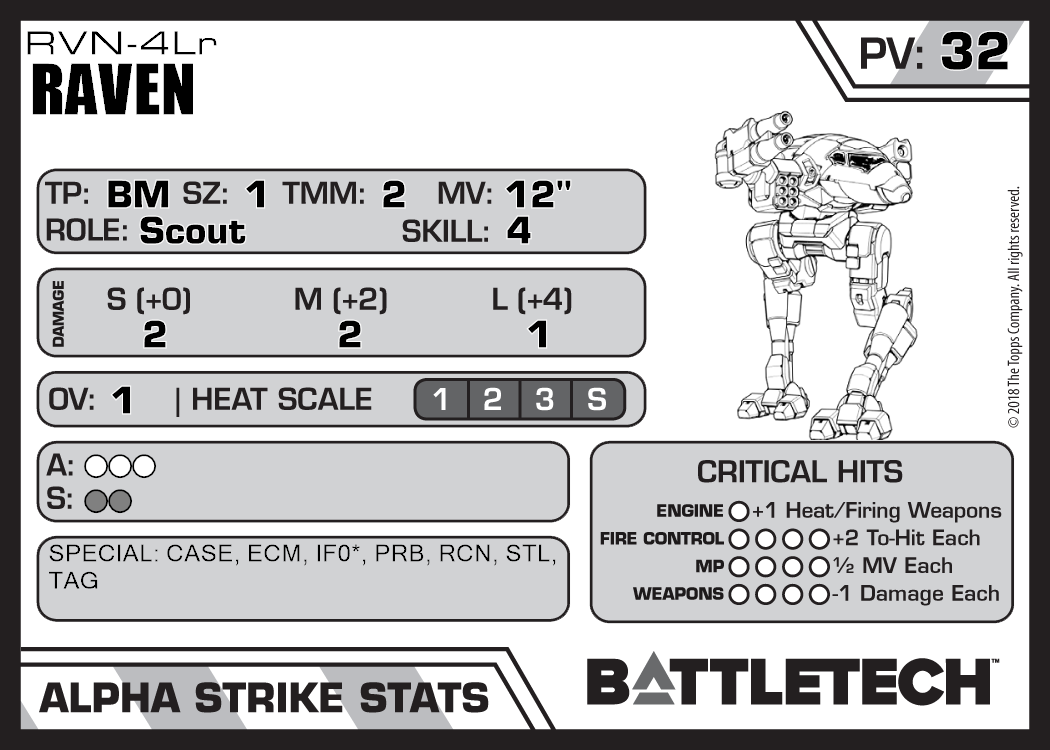
If there's one thing to be said about Ravens, it's that they never really stop getting nastier. The -4X is a bit of an anomaly, but it's also adrift in the currents of time as far as naming conventions go (they go -1X, -3X, -2X, -4X, -3L in order of introduction date). The -4Lr is the nastiest Raven we've seen yet. With a 2/2/1 damage with OV1, it's the hardest hitter among any Raven so far. It managed to inherit the best parts about the -4L and -3M, including most of the Specials. In fact, it has all of the Specials of
both the -4L and -3M, minus the -3L's SNARC. That includes the -4L's STL. With a long range damage value, STL is now more valuable than ever, penalizing return fire against a long range Raven by +6. The retention of the -3M's IF1 also grants some additional flexibility.
At 28 points, the -4Lr is the most expensive Raven available. You get what you pay for. This Raven does dip into the Missile Boat role, for some extra interesting force construction options, as mentioned earlier.
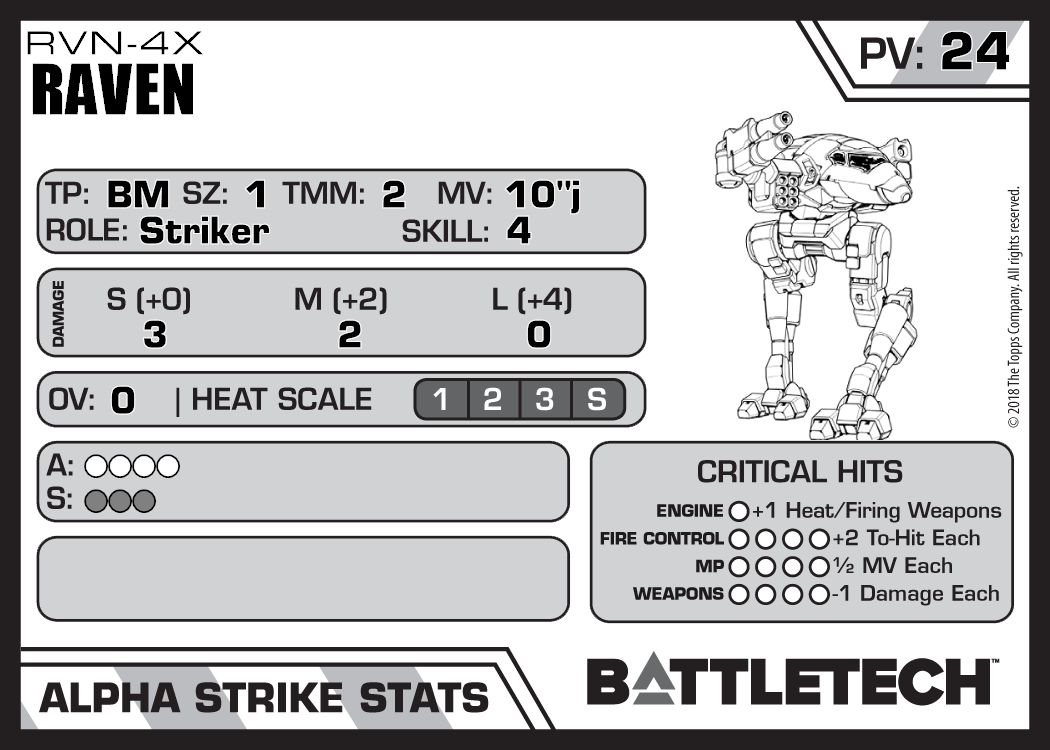
The Raven -4X takes everything we know about Ravens and destroys it. Brutally, without remorse. Every single other Raven so far has moved either 10” or 12”, had either two or three points of armor or structure each, and done no more than 2 damage in any given range band.
The -4X starts off strong with a 10”j, the first (and only) Raven to mount jump jets. This gives it a TMM of +2 while walking normally, but it can during its movement phase declare that it will be jumping. This automatically adds +1 to the TMM normally associated with its jump range (in this case, 10” is +2, jumping adds +1 for a total of +3 TMM; some jump movements are greater or smaller than normal movement). A jump makes any shots the -4X itself takes less accurate, however. Sometimes it's worth it to be able to cross otherwise impassable terrain.
Also very different: The first instance of more than 2 damage without pumping up the cockpit temperature. With a short range damage of 3, the Raven -4X is the single most powerful Raven we've yet seen in terms of hitting power. It loses the long range damage, but with the increased mobility and maneuverability from mounting jump jets this is less of a loss than it otherwise appears.
The other reason that's less of a loss than it might seem is the armor. The -4X is also hands down the most heavily armored Raven we've seen to date. Considering this is Raven #9 on the list, that's saying something. Four points of armor and three points of structure make one-shotting this little birdy fairly difficult, and it passes the fairly important threshold of being able to take two different three point hits and still be able to run away. Since three points is one of the more common medium and heavy 'Mech damage values, that's pretty significant.
The only thing dragging the -4X down is its total lack of Specials. It's a line unit, a light cavalry 'Mech that exists in order to bully other lights into submission with superb armor and good guns. It's definitely a good 'Mech, but it's just not the same as the rest of the Ravens and their support roles. At 24 points, it's still pretty affordable and the Striker role is flexible. The -4X represents a choice between support capability and raw combat capability.
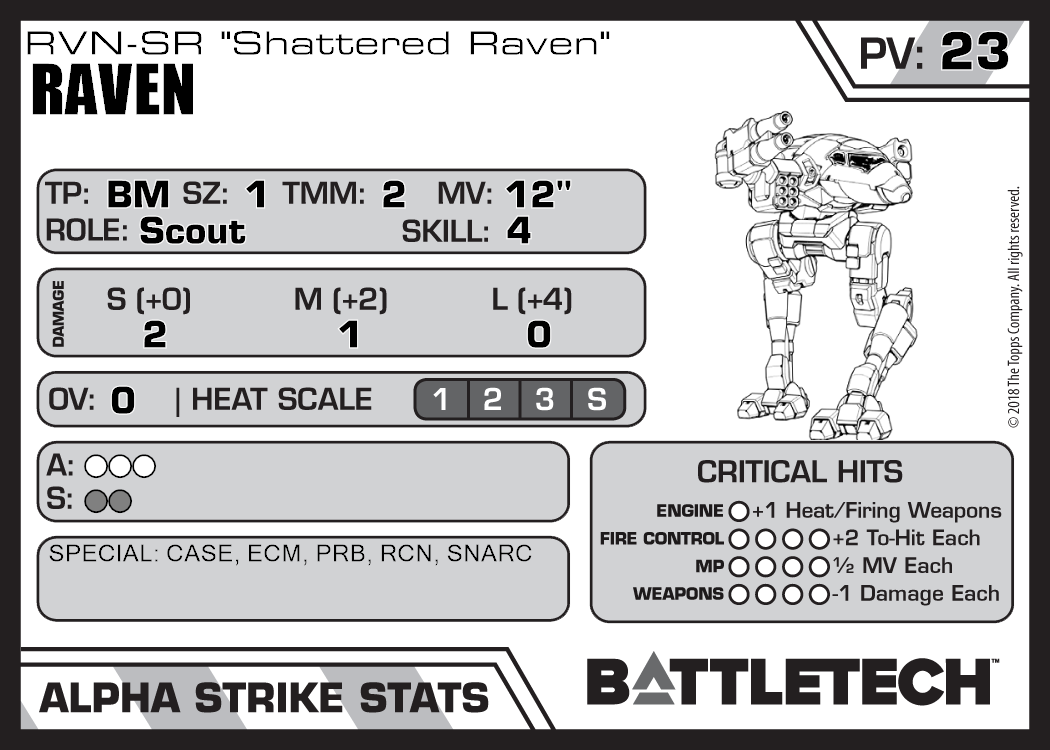
And now we're getting into the less well known Ravens. I'll be honest: I didn't even know the -5SR “Shattered Raven” even existed until I clicked on the MUL today. Apparently I wasn't missing a whole lot. This thing is almost identical to the -3L, with one fewer point of midrange damage and no TAG. Those are the only differences, and the point values reflect the loss of damage exactly. For 22 points you get what you pay for. The other minor difference is that this one is a Scout, while the -3L is a Striker.
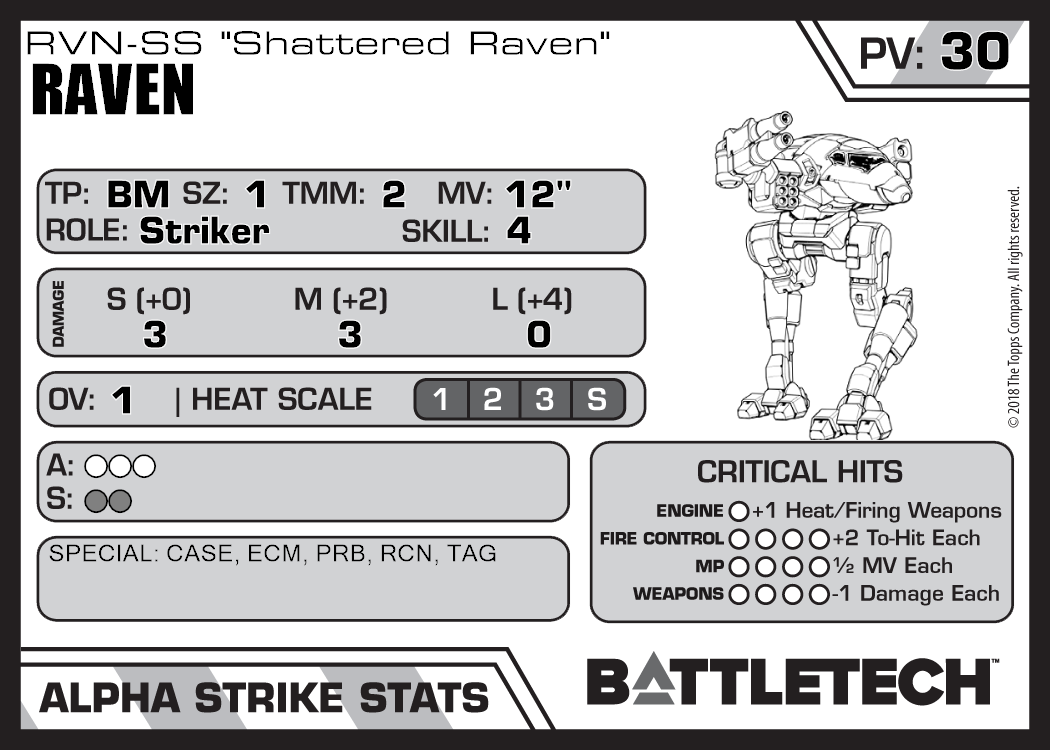
Apparently there are two “Shattered Raven”s. The -5SS is significantly more interesting, despite sharing the same nickname. It's a pretty prickly thing, too. 3/3/0 with OV1 is far and away the most damaging Raven in the entire bunch, especially at medium range. The potential to do up to 4 points of damage is something that no other Raven matches. Period. Speed is good enough to absorb the minor loss in movement for a turn, but the armor is back to the Raven standard. That is, slightly lacking, but enough to take on other Lights. Twenty seven points buys you a -5SS, just barely edged out by the -4Lr for the title of Most Expensive Raven. You get what you pay for (are you sick of that yet? It's true). It trades off in the traditional Raven fashion with the -5SR, playing the Striker to the previous variant's Scout.
There is technically another Raven, the Raven X in XTRO Liao. Well, technically two, counting the Raven II in TRO3145 Liao. I'll get to both of those another time. This article has already run long, and I'll need something to put in with the Raven II article anyway.
The Raven can be found at the
MUL, and examples of the miniatures can also be found on
Camospecs.Next week: Uraeus, by request.

